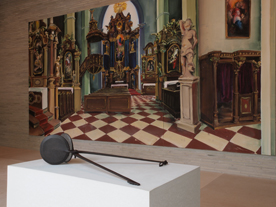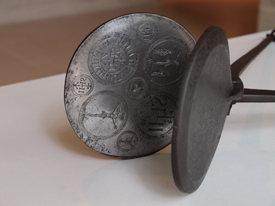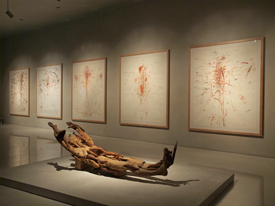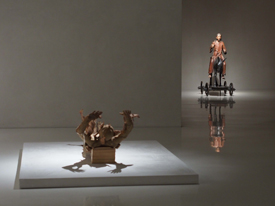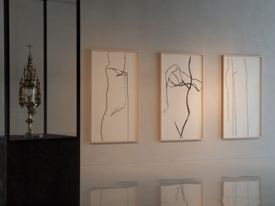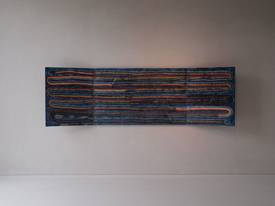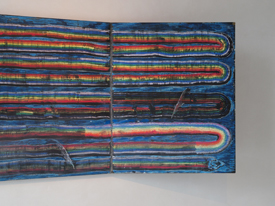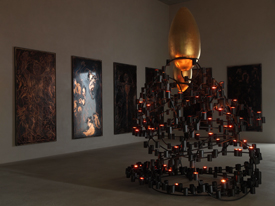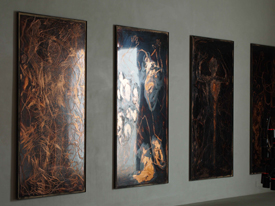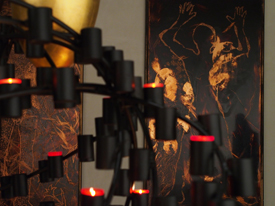15 September 2012 – 18 August 2013
Art is Liturgy
Paul Thek and the Others
»Art is Liturgy« is a quote by American artist Paul Thek (1933-1988), taken from an interview Harald Szeemann conducted with him in 1973. »Art is Liturgy, and if the public responds to their sacred character, then I hope I realized my aim, at least at that instance.« With this statement, the title of this year's annual exhibition, Thek succinctly expresses his self-understanding as an artist. In 1972, Paul Thek participated with a large installation in the documenta V, which created a consciousness for spirituality and transcendence in contemporary art with the art historical concept of »Individual Mythologies«. In taking recourse to models that shape his philosophy, in the precision of his images and metaphors, and with subtle humor, Thek unfolds a notion of art that still applies today in terms of its political, cultural, and social relevancy. The powerful staging of his installations may not be reconstructed without having to neglect the processional nature, which is characteristic for his art. The curatorial challenge lies in dealing with a work that itself was meant to remain unfinished, its inherent claim for contextual renewal, and beyond this, its only having come down to us in fragments. It makes us aware of the performance quality of works of art, since without staging them, there is no way to show them in public. Kolumba owns the most extensive collection of works by the artist, which we are able to present here for the first time now that major works have returned from their tour in America. In numerous dialogues with other works in our collection, we would like to provide a space we consider to be self-evident, though not definitive, in which the poetry and seriousness of Paul Thek's oeuvre may resonate. It allows his artistic intentions to become palpable and gives the works a new place of their own. How does art react with liturgy, which itself uses artistic means? »To engage in play before God - to be a work of art, but not to create it - this is the innermost essence of liturgy,« wrote the theologian and priest Romano Guardini in 1918. What impulses for art may be attributed to this 2000-year tradition? What impulses can art give to liturgy? Concepts such as space, time, order, body, action, and play are key themes of the exhibition. The subtitle indicates dialogues with groups of works shown for the first time by Herbert Falken, Rebecca Horn, Chris Newman and Jürgen Paatz, and others. With his contribution to the documenta in 1992 - a spectacular new acquisition for the collection - Cologne artist Michael Buthe (1944-1994) has been singled out in particular. The exhibition considers itself as being the preparatory, cultural launch of the "Eucharistic Congress", which the Cologne Archdiocese is organizing on behalf of the German Bishops' Conference this coming June. It is dedicated to the memory of Joseph Geller, last pastor at St. Kolumba and builder of the chapel »Madonna in the Ruins«.
Art-Works by Krimhild Becker, Mira Bergmüller, Joseph Beuys, Michael Buthe, Herbert Falken, Rebecca Horn, Jürgen Klauke, Robert Klümpen, Jannis Kounellis, August Macke, Chris Newman, Walter Ophey, Jürgen Paatz, Oskar Schlemmer, Lothar Schreyer, Jan Thorn-Prikker, Manos Tsangaris a.o.
»Paul Thek. Shrine« – The long expected book on the Thek-collection of Kolumba
Art-Works by Krimhild Becker, Mira Bergmüller, Joseph Beuys, Michael Buthe, Herbert Falken, Rebecca Horn, Jürgen Klauke, Robert Klümpen, Jannis Kounellis, August Macke, Chris Newman, Walter Ophey, Jürgen Paatz, Oskar Schlemmer, Lothar Schreyer, Jan Thorn-Prikker, Manos Tsangaris a.o.
»Paul Thek. Shrine« – The long expected book on the Thek-collection of Kolumba
